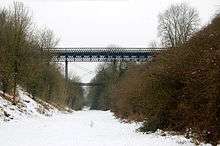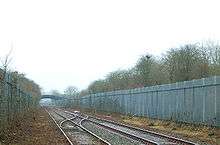Leamington to Rugby Line
The Leamington to Rugby Line was a railway running from Leamington Spa to Rugby. It was a 15-mile branch line built by the London & North Western Railway (LNWR) and opened in 1851 The branch connected Leamington with the mainline from London to Birmingham (now the West Coast Main Line which had been opened in 1838 by the LNWR's predecessor, the London & Birmingham Railway (L&BR).
| Leamington Spa former branch lines | |||||||||||||||||||||||||||||||||||||||||||||||||||||||||||||||||||||||||||||||||||||||||||||||||||||||||||||||||||||||||||||||
|---|---|---|---|---|---|---|---|---|---|---|---|---|---|---|---|---|---|---|---|---|---|---|---|---|---|---|---|---|---|---|---|---|---|---|---|---|---|---|---|---|---|---|---|---|---|---|---|---|---|---|---|---|---|---|---|---|---|---|---|---|---|---|---|---|---|---|---|---|---|---|---|---|---|---|---|---|---|---|---|---|---|---|---|---|---|---|---|---|---|---|---|---|---|---|---|---|---|---|---|---|---|---|---|---|---|---|---|---|---|---|---|---|---|---|---|---|---|---|---|---|---|---|---|---|---|---|---|
Legend | |||||||||||||||||||||||||||||||||||||||||||||||||||||||||||||||||||||||||||||||||||||||||||||||||||||||||||||||||||||||||||||||
| |||||||||||||||||||||||||||||||||||||||||||||||||||||||||||||||||||||||||||||||||||||||||||||||||||||||||||||||||||||||||||||||
| |||||||||||||||||||||||||||||||||||||||||||||||||||||||||||||||||||||||||||||||||||||||||||||||||||||||||||||||||||||||||||||||
History
The original proposal for the line was put forward by the Rugby, Leamington and Warwick Railway Company (which soon became the Rugby and Leamington Railway). The Act for the railway received Royal Assent on 13 August 1846. The undertaking was sold to the LNWR on 17 November 1846.
However, the line from Rugby was not the first to reach Leamington. The L&BR had opened a branch from its mainline at Coventry in 1844 which terminated at Milverton, midway between Leamington and Warwick. This terminal station was originally called Leamington despite being a mile from the town. When the LNWR line from Rugby was built in 1851, it extended west of Leamington crossing the River Leam on a stone viaduct to make an end-on connection to the branch from Coventry.
Meanwhile, however, the Great Western Railway (GWR) Oxford to Birmingham line was being constructed through Leamington and the line from Rugby ran parallel to it. The GWR's original Leamington station opened in 1852 and its successor on the same site is still open today. Two years later, the LNWR opened its own station alongside the GWR station. The LNWR's station was north of the GWR's and at a slightly lower level. This new station was named Leamington Avenue and the former LNWR terminus on the line from Coventry was renamed Warwick (Milverton).
The line from Rugby to Leamington opened throughout on 1 March 1851. It was originally built as single track but as traffic grew the line was doubled in stages from Rugby: by January 1884 the whole route to Milverton was double track. The lines were designated Up to Rugby and Down to Leamington.
The Leamington branch diverged from the LNWR mainline half-a-mile west of Rugby station at Trent Valley Junction. Local trains for Leamington used the down (north) end bay platforms at Rugby. At the other end of the line, services from Rugby ran through to Warwick (Milverton) and this practice continued until closure because the loco shed and servicing depot for the Rugby-Leamington-Coventry lines was at Milverton.
In 1895, a junction was constructed when the single track line from Weedon to Daventry was extended westward to join the Rugby to Leamington line. Marton Junction was two miles west of Marton station in a deep cutting through a ridge of high ground. The junction remained in use until the withdrawal in the mid-1980s of the infrequent freight trains supplying the Rugby Portland Cement Company's works beside the line near Long Itchington.
Before that, however, regular passenger services on the Rugby to Leamington line had been withdrawn in June 1959 (although diverted passenger services occasionally used the line after this date). General goods traffic lasted a few years longer but the line closed as a through route in the mid-1960s. However, as noted above, the line from Rugby as far as Marton Junction (together with the first three miles of the line towards Weedon) remained open until freight services to the cement works finished.
Stations

There were three intermediate stations between Rugby and Leamington Avenue. The stations at Birdingbury and Marton opened when the line was built. Dunchurch station was built twenty years later and opened in October 1871.
Birdingbury station closed as early as 1953 but the other two stations remained open until the end of regular freight services in the early 1960s.
The station houses at Dunchurch and Birdingbury are now private residences (even the platforms are still in place at Birdingbury) but there is little trace of Marton station itself and a small industrial estate occupies the site.
Route

From Rugby, the general course of the line was southwest as far as Hunningham after which it swung west for the last five miles into Leamington. Most of the route was straight and lightly graded. For the first few miles out of Rugby the line was mainly routed in shallow cuttings but west of Birdingbury it crossed the River Leam on a low viaduct. From there it ran across the flat open expanse of Marton Moor before cutting through high ground to follow the valley of the River Leam for the last few miles.
The route had three civil engineering features of note: the deep cutting at Marton Junction; the lofty wrought-iron bridge spanning the cutting; and the viaduct over the canal near Radford Semele.
The cutting, approximately 60 feet deep, took the line through a north-south ridge of high ground south of Hunningham. An ancient track, Ridgeway Lane, ran along the top of the ridge and met the cutting at its deepest point so the LNWR built a single-span wrought-iron trussed lattice girder bridge to carry the lane over the railway. At the time it was built (1851) this was the longest such bridge ever constructed. In later years, four lattice columns and cross-ties were added to reinforce the original structure. Known locally as 'the high bridge', this impressive example of Victorian civil engineering is still standing.
Two miles further west, the handsome five-arch brick-built Offchurch Viaduct carried the route over the Grand Union Canal and adjacent low ground: the arch above the canal itself was built with skewed courses. The viaduct still stands although the trackbed across it is fenced off.
The line today

At the Rugby end of the line the first half-mile of track is still in use as a siding. The rest of the line has been dismantled and no track remains.
Much of the dismantled trackbed is intact but only a few sections are public rights of way. The trackbed from Draycote (southwest of the former Dunchurch station) to Birdingbury has been surfaced by Sustrans as part of National Cycle Network Route 41.[1] The long straight stretch of trackbed from the A423 across Marton Moor to the cutting near Hunningham is mostly clear of undergrowth and is regularly used by walkers; however, there is no legal right of way and this section can be very muddy in winter.
Further west, a 1.5-mile (2.4 km) stretch of trackbed from the Fosse Way to the Grand Union Canal, titled 'Offchurch Greenway' [2] and also part of Route 41, is well surfaced and maintained. West of the canal, the trackbed is on private land as far as the A425 road and beyond that most of the old railway has been built over.
Within Royal Leamington Spa itself, the route parallels the Chiltern Main Line for approximately 550 yards (500 m) east of Leamington Spa railway station on a series of brick viaducts that remain in situ. However sections formerly occupied by metal-construction bridges over roads have been removed. There is no access to the vidaucts, however the archways underneath are used by small businesses.
See also
References and sources
- Vic Mitchell and Keith Smith, 2008, Rugby to Birmingham including connections to Leamington Spa, Middleton Press, ISBN 978-1-906008-37-6
- Geoffrey Kingscott, 2009, Lost Railways of Warwickshire, Countryside Books, ISBN 978-1-84674-174-6
- Richard Coleman and Joe Rajczonek, 1988, Steaming into Northamptonshire, Northamptonshire Libraries, ISBN 0-905391-12-8
- Hendry and Hendry, 1982, An historical survey of selected LMS stations Vol 1, Oxford Publishing Company, ISBN 0-86093-168-4
- W P Connolly, 1976, Pre-Grouping Atlas and Gazetteer, Ian Allan Ltd, ISBN 0-7110-0320-3
- Last Day on the Daventry Branch article, Railway Bylines magazine volume 11, issue 9, August 2006
- Ordnance Survey, Landranger 1:50000 scale map, Sheet 151, ISBN 978-0-319-23178-4
- Warwickshire Railways website (Editor's note: Warwickshire Railways is a useful resource but some of the dates given are incorrect; treat this resource with caution)